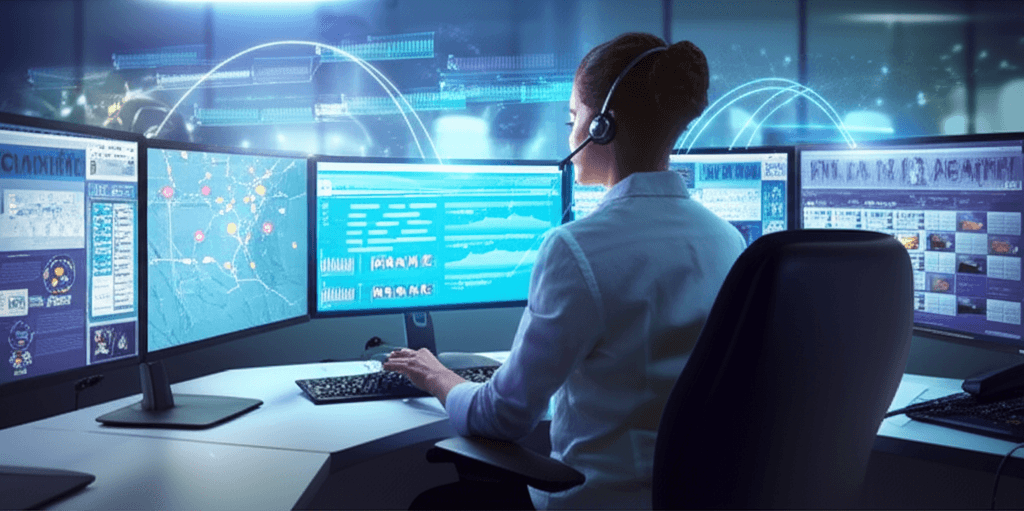New Era for 911: AI Supercharges Dispatchers, Saving More Lives
AI is revolutionizing 911 centers by augmenting human dispatchers' capabilities, improving response times, and easing pressure in critical moments.
July 3, 2025

In the pressurized environment of a 911 call center, where every second is critical, the prospect of artificial intelligence can seem both promising and daunting. Yet, the narrative that AI is set to replace human dispatchers is being reshaped by a more collaborative reality. Across the country, public safety answering points (PSAPs) are integrating AI not as a replacement for human expertise, but as a powerful tool to augment their capabilities.[1][2] This technology is transforming the public safety landscape by automating routine tasks, analyzing vast amounts of data in real-time, and ultimately providing dispatchers with enhanced situational awareness to make faster, more informed decisions.[3][4][5] The integration is aimed at easing the immense pressure on dispatchers, who face challenges like staffing shortages and overwhelming call volumes, particularly during large-scale emergencies.[6][7]
One of the most significant impacts of AI in emergency dispatch is its ability to process and prioritize incoming information with incredible speed and accuracy. AI-driven systems can analyze voice patterns, keywords, and even the emotional tone of a caller to help gauge the urgency of a situation.[8][9] This allows for intelligent call triage, automatically categorizing and prioritizing the most critical incidents, such as cardiac arrests or active threats, ensuring they receive immediate attention.[10][11][9] For example, some AI systems can detect a higher proportion of out-of-hospital cardiac arrest cases in the first minute compared to human dispatchers alone.[10] Furthermore, AI excels at handling non-emergency calls, which can divert significant resources from true emergencies.[12] In one case, an AI system resolved over 30% of incoming calls without call-taker interaction by identifying them as non-emergency or general information queries, freeing up human dispatchers to focus on life-threatening situations.[3][12] This automation of routine tasks and initial call assessments helps to reduce dispatcher workload and burnout, a critical issue in a field with high vacancy rates.[13][1][7]
Beyond call triage, AI is proving invaluable in its ability to analyze and synthesize data from multiple sources to create a comprehensive operational picture.[14] As dispatch centers transition to Next Generation 911 (NG911), which supports multimedia like text, images, and video, AI algorithms can process this influx of information to provide crucial insights.[14][15] For instance, AI can analyze surveillance footage to identify emergencies before they are even reported or use geofencing to pinpoint the exact location of a major incident by tracking call hotspots during a surge.[3][9][16] This capability for real-time data analysis allows for predictive analytics, where historical data on weather patterns, traffic conditions, and past incidents can be used to forecast potential emergencies and optimize the deployment of resources.[8][4][17] This proactive approach enhances the situational awareness of both dispatchers and first responders, allowing them to anticipate needs and adapt their strategies to evolving situations.[9][16]
The integration of AI also addresses fundamental communication barriers. Real-time language translation is a key feature of many new AI systems, allowing dispatchers to communicate effectively with callers who do not speak English.[8][18][1] This is a critical development for ensuring equitable access to emergency services in diverse communities.[8] AI-powered transcription services can create an accurate, real-time text record of calls, reducing the potential for miscommunication and providing a clear log for review and quality assurance.[3][2] Some systems can even analyze audio for specific sounds, like breaking glass or gunshots, providing additional context to the dispatcher. This suite of tools works together to alleviate the cognitive load on dispatchers, allowing them to focus on the essential human elements of the job: empathy, critical thinking, and complex decision-making.[3][12] The prevailing model is one of "human-in-the-loop," where AI provides support and data, but the final, crucial decisions remain in the hands of trained professionals.[19][7]
In conclusion, artificial intelligence is not diminishing the role of emergency dispatchers but is instead fortifying it. By automating repetitive tasks, providing deep analytical insights, and breaking down communication barriers, AI is functioning as a force multiplier, allowing human operators to perform their life-saving work more efficiently and effectively.[1] The technology helps to manage the immense data flow of modern emergency communications and provides tools to quickly make sense of chaotic situations.[14][5] While challenges such as data privacy, potential algorithmic bias, and the need for robust cybersecurity must be carefully managed, the trajectory is clear.[8][6][20] The collaboration between human expertise and artificial intelligence is poised to continue to evolve, leading to faster response times, better resource allocation, and ultimately, safer communities.[21][22]
Sources
[1]
[2]
[3]
[5]
[6]
[7]
[8]
[9]
[10]
[11]
[12]
[13]
[14]
[15]
[16]
[17]
[18]
[19]
[20]
[22]